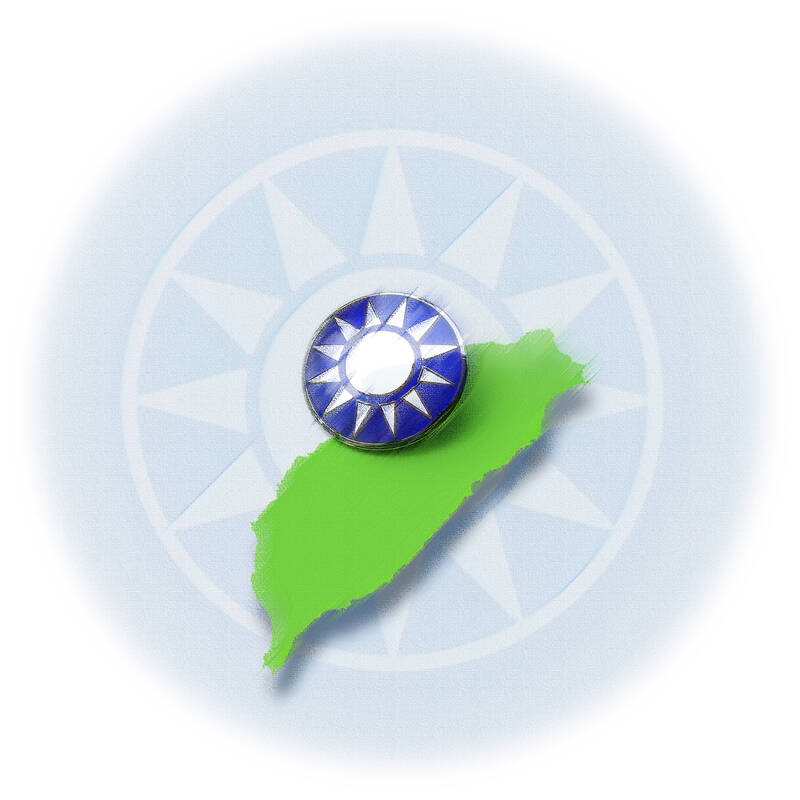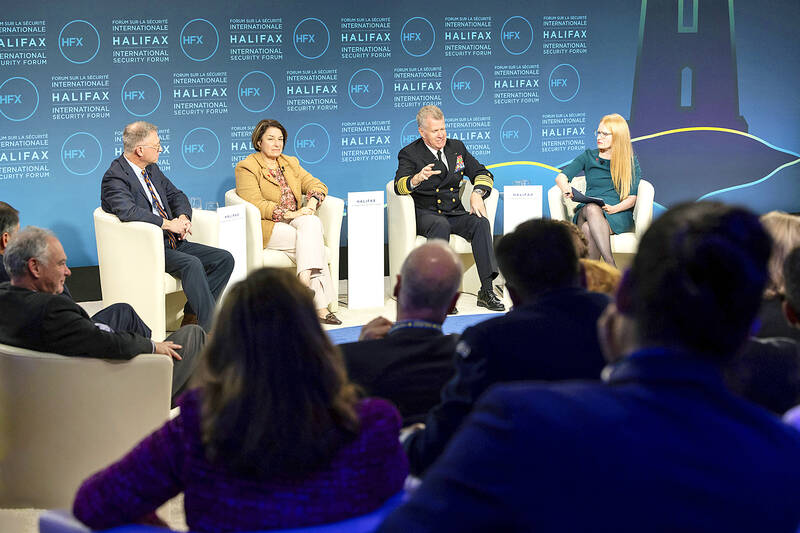US Indo-Pacific Commander Admiral Samuel Paparo, speaking at the Reagan Defense Forum last week, said the US is confident it can defeat the People’s Republic of China (PRC) in the Pacific, though its advantage is shrinking. Paparo warned that the PRC might launch a “war of necessity” even if it thinks it could not win, a wise observation.
As I write, the PRC is carrying out naval and air exercises off its coast that are aimed at Taiwan and other nations threatened by PRC expansionism. A local defense official said that China’s military activity on Monday formed two “walls” east of Taiwan to secure control of the Taiwan Strait and block the access of other countries.
Legislator Chen Kuan-ting (陳冠廷) of the Democratic Progressive Party (DPP) warned that the PRC military drills are growing larger, involving more civilian and military units, and display growing civilian-military integration pacing more complex abilities.

GRAPHIC: TT
LOYALTY TO TAIWAN OR PRC?
We could have more civilian-military integration here in Taiwan, but the Chinese Nationalist Party (KMT) is fighting that. KMT legislators have proposed adding an age restriction for service on civil defense teams. The draft amendment to Article 15 of the All-out Defense Mobilization Readiness Act (全民防衛動員準備法) proposed by KMT Legislator Hsu Chiao-hsin (徐巧芯), according to a Taipei Times report, “aims to abolish the mobilization of school youth for all-out national defense.”
The purpose of that change is to reduce the ability of people under 20 to participate in civil defense, as DPP legislators observed in the legislative discussion. Oddly, despite its claim to be protecting the nation’s young, the KMT has not moved to restrict youths from being conscripted for military service, a law that currently applies to all males when they reach the age of 18.

Photo: Liao Chen-huei, Taipei Times
As PRC naval and air units demonstrated around Taiwan, the KMT posted to X: “We urge the @dpponline gov’t to stop sabotaging the exchanges b/w the two sides of the Taiwan Straits. The #peace & #stability need to be maintained through #dialogue rather than confrontation.”
No condemnation of PRC aggression, of course.
Instead, Chiang Wan-an (蔣萬安), the KMT mayor of Taipei, is preparing to host another cross-strait forum (the Mainland Affairs Council reserved the right to delay the trip if PRC escalates its anti-Taiwan military activities). Former president Ma Ying-jeou (馬英九) said last week that on Dec. 26 he will lead a group of students from Taiwan to tour the PRC. KMT caucus whip Fu Kun-chi ( 傅?萁) was just in Hong Kong.

Photo: AP
It’s obvious where KMT loyalties lie.
The good news is, the KMT’s anti-Taiwan strategy is PRC-centered, negative, reactionary and defense-focused. That was illustrated this week by the sudden proposal to alter the martial law powers of the president. Currently, the president gets a month of martial law before he has to submit it to the legislature for approval. Under the KMT proposal, the president would have to submit it to the legislature for review within 56 hours, or it is immediately canceled. That is not a bad thing, but the KMT was not getting out in front of events, but reacting to the events in South Korea last week.
Reviewing the KMT’s legislative agenda, it is striking how little of it is focused on improving the lot of the common people. The party has a precious opportunity to improve its electoral position, and it is frittering it away pleasing the PRC.
This demonstrates something I have often noted, a difficult thing for outsiders to grasp, which is that the KMT is not really a political party. Instead, it is the political organization of a colonial ruling class, a Leninist one to boot, forced to act like a political party by the strictures of democracy. As soon as it gets any kind of power, it begins to display the characteristics of a colonial ruling class, becoming extractive, motherland-focused and arrogantly unconcerned about the plight of the people it rules.
FACTIONS
President William Lai (賴清德) put his finger on the KMT’s problem: it has traditionally run Taiwan though links to powerful local factions whose wealth depends on flows from the old construction-industrial state.
On the campaign trail last December, Lai attacked the KMT for its close relations with the Chang (張) family of Yunlin, the Lo (羅) family in Taipei, the Yen (顏) family of Taichung and the Fu (傅) clan in Hualien. Lai contended that these families have great power within the KMT.
These factions are slowly hollowing out the KMT. The Chang family of Yunlin is especially powerful. A 2018 Taipei Times report on the conviction of powerful faction member Chang Jung-wei (張榮味) in a case dating back 14 years declared: “pundits and social commentators said that Chang’s family had dominated Yunlin politics for the past two decades, and from his base in Yunlin, he controlled many of the transportation, sales and agricultural marketing networks in Taiwan.”
Indeed, it was the backing of Chang Jung-wei that secured for current Legislative Speaker Han Kuo-yu (韓國瑜) the position of general manager of the Taipei Agricultural Products Marketing Corporation in January 2013. It is not a coincidence that Han had the support of powerful local faction networks in his campaigns for Kaohsiung mayor and later, president. It is interesting to imagine who really would have been running Taiwan had Han been elected.
It should not be forgotten that just as Fu Kun-chi went off to Hong Kong earlier this month, one of Han’s first official acts as mayor of Kaohsiung was a seven-day trip with 10 KMT city councilors to the PRC, Macao and Hong Kong. Last month, KMT heavyweight Wang Jin-pyng (王金平), long considered the de facto head of the Taiwanese in the KMT, visited the PRC as well.
The Yen family of Taichung, also named by Lai, which controls the Dajia Mazu Temple (the Mazu cult is a key channel for pro-PRC links), has long cultivated links with the PRC. In May of 2009, a boat carrying Cheng Ming-kun (鄭銘坤), a Yen family associate, and a load of Mazu pilgrims was the first passenger ferry to cross the strait. It was seen off by powerful faction head Yen Ching-piao (顏清標). The Mazu cult is one dimension of the numerous links between the PRC’s “united front” organizations and activities and local factions in Taiwan.
These links, and the constant flow of trips by Taiwanese faction politicians to the PRC, show that even if the Mainlander elites who run the KMT are eventually eclipsed by powerful Taiwanese factions, the KMT will go right on being the PRC’s catspaw in Taiwan.
Maybe Taiwanization of the KMT isn’t the answer.
Notes from Central Taiwan is a column written by long-term resident Michael Turton, who provides incisive commentary informed by three decades of living in and writing about his adoptive country. The views expressed here are his own.

June 2 to June 8 Taiwan’s woodcutters believe that if they see even one speck of red in their cooked rice, no matter how small, an accident is going to happen. Peng Chin-tian (彭錦田) swears that this has proven to be true at every stop during his decades-long career in the logging industry. Along with mining, timber harvesting was once considered the most dangerous profession in Taiwan. Not only were mishaps common during all stages of processing, it was difficult to transport the injured to get medical treatment. Many died during the arduous journey. Peng recounts some of his accidents in

What does the Taiwan People’s Party (TPP) in the Huang Kuo-chang (黃國昌) era stand for? What sets it apart from their allies, the Chinese Nationalist Party (KMT)? With some shifts in tone and emphasis, the KMT’s stances have not changed significantly since the late 2000s and the era of former president Ma Ying-jeou (馬英九). The Democratic Progressive Party’s (DPP) current platform formed in the mid-2010s under the guidance of Tsai Ing-wen (蔡英文), and current President William Lai (賴清德) campaigned on continuity. Though their ideological stances may be a bit stale, they have the advantage of being broadly understood by the voters.

Artifacts found at archeological sites in France and Spain along the Bay of Biscay shoreline show that humans have been crafting tools from whale bones since more than 20,000 years ago, illustrating anew the resourcefulness of prehistoric people. The tools, primarily hunting implements such as projectile points, were fashioned from the bones of at least five species of large whales, the researchers said. Bones from sperm whales were the most abundant, followed by fin whales, gray whales, right or bowhead whales — two species indistinguishable with the analytical method used in the study — and blue whales. With seafaring capabilities by humans

In a high-rise office building in Taipei’s government district, the primary agency for maintaining links to Thailand’s 108 Yunnan villages — which are home to a population of around 200,000 descendants of the Chinese Nationalist Party (KMT) armies stranded in Thailand following the Chinese Civil War — is the Overseas Community Affairs Council (OCAC). Established in China in 1926, the OCAC was born of a mandate to support Chinese education, culture and economic development in far flung Chinese diaspora communities, which, especially in southeast Asia, had underwritten the military insurgencies against the Qing Dynasty that led to the founding of